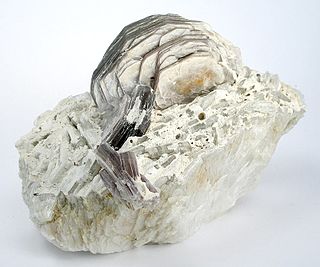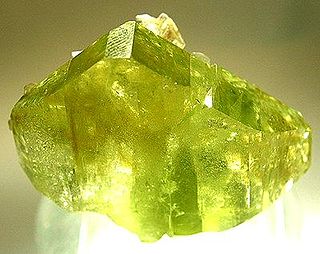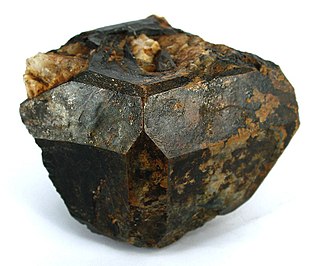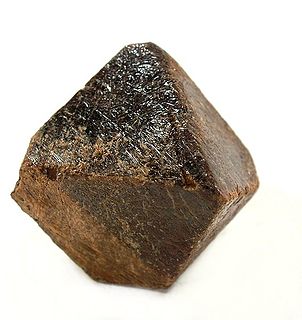
A pegmatite is an igneous rock, formed underground, with interlocking crystals usually larger than 2.5 cm in size (1 in). Most pegmatites are found in sheets of rock near large masses of igneous rocks called batholiths.

Lepidolite is a lilac-gray or rose-colored member of the mica group of minerals with formula K(Li,Al,Rb)2(Al,Si)4O10(F,OH)2. It is the most abundant lithium-bearing mineral and is a secondary source of this metal. It is a phyllosilicate mineral and a member of the polylithionite-trilithionite series.

Brazilianite, whose name derives from its country of origin, Brazil, is a typically yellow-green phosphate mineral, most commonly found in phosphate-rich pegmatites.

Lanthanites are a group of isostructural rare earth element (REE) carbonate minerals. This group comprises the minerals lanthanite-(La), lanthanite-(Ce), and lanthanite-(Nd). This mineral group has the general chemical formula of (REE)2(CO3)3·8(H2O). Lanthanites include La, Ce, and Nd as major elements and often contain subordinate amounts of other REEs including praseodymium (Pr), samarium (Sm), europium (Eu) and dysprosium (Dy). The lanthanite crystal structure consists of layers of 10-fold coordinated REE-oxygen (O) polyhedra and carbonate (CO32−) groups connected by hydrogen bonds to interlayer water molecules, forming a highly hydrated structure.

Microlite was once known as a pale-yellow, reddish-brown, or black isometric mineral composed of sodium calcium tantalum oxide with a small amount of fluorine (Na,Ca)2Ta2O6(O,OH,F). Today it is a name of a group of oxide minerals of a similar stoichiometry having tantalum prevailing over titanium and niobium. The microlite group belongs to a large pyrochlore supergroup that occurs in pegmatites and constitutes an ore of tantalum. It has a Mohs hardness of 5.5 and a variable specific gravity of 4.2 to 6.4. It occurs as disseminated microscopic subtranslucent to opaque octahedral crystals with a refractive index of 2.0 to 2.2. Microlite is also called djalmaite, but both names are now obsolete.

Hydrokenoelsmoreite is a hydrous tungsten oxide mineral with formula □2W2O6(H2O). Hydrokenoelsmoreite is a colorless to white, translucent isometric mineral. It has a Mohs hardness of 3, exhibits no cleavage and has a splintery fracture. It has a vitreous to adamantine luster. It is optically isotropic with an index of refraction of n = 2.24.

Betafite is a mineral group in the pyrochlore supergroup, with the chemical formula (Ca,U)2(Ti,Nb,Ta)2O6(OH). Betafite typically occurs as a primary mineral in granite pegmatites, rarely in carbonatites. Defined by the B-site atom Ti, Atencio et al.(2010) combined and considered the ideas portrayed in (Hatert and Burke)(2008) and a modernization of (Hogarth)(1977) system for nomenclature of pyrochlore and betafite in order to further rationalize the naming process of this grouping of minerals. Therefore, Atencio et al. (2010), states that only two of the mineral species that were formerly recognized under the previous nomenclature system of betafite in Hogarth (1977) are now recognized. They are oxyuranobetafite and oxycalciobetafite. Now the term betafite is a synonym or varietal group name under the pyrochlore super group (Christy and Atencio 2013).
Eudialyte group is a group of complex trigonal zircono- and, more rarely, titanosilicate minerals with general formula [N(1)N(2)N(3)N(4)N(5)]3[M(1a)M(1b)]3M(2)3M(4)Z3[Si24O72]O'4X2, where N(1) and N(2) and N(3) and N(5) = Na+ and more rarely H3O+ or H2O, N(4) = Na+, Sr2+, Mn2+ and more rarely H3O+ or H2O or K+ or Ca2+ or REE3+ (rare earth elements), M(1) and M(1b) = Ca2+, M(1a) = Ca2+ or Mn2+ or Fe2+, M(2) = Fe (both II and III), Mn and rarely Na+, K+ or Zr4+, M(3) = Si, Nb and rarely W, Ti and [] (vacancy), M(4) = Si and or rarely [], Z Zr4+ and or rarely Ti4+, and X = OH−, Cl− and more rarely CO32− or F−. Some of the eudialyte-like structures can even be more complex, however, in general, its typical feature is the presence of [Si3O9]6− and [Si9O27]18− ring silicate groups. Space group is usually R3m or R-3m but may be reduced to R3 due to cation ordering. Like other zirconosilicates, the eudialyte group minerals possess alkaline ion-exchange properties, as microporous materials.

Wodginite is a manganese, tin, tantalum oxide mineral with formula Mn2+(Sn,Ta)Ta2O8. It may include significant niobium.

Fluor-liddicoatite is a rare member of the tourmaline group of minerals, elbaite subgroup, and the theoretical calcium endmember of the elbaite-fluor-liddicoatite series; the pure end-member has not yet been found in nature. Fluor-liddicoatite is indistinguishable from elbaite by X-ray diffraction techniques. It forms a series with elbaite and probably also with olenite. Liddiocoatite is currently a non-approved mineral name, but Aurisicchio et al. (1999) and Breaks et al. (2008) found OH-dominant species. Formulae are
Nabalamprophyllite has a general formula of Ba(Na,Ba){Na3Ti[Ti2O2Si4O14](OH,F)2}. The name is given for its composition (Naba, meaning sodium, Na and barium, Ba) and relation to other lamprophyllite-group minerals. Lamprophyllite is a rare Ti-bearing silicate mineral usually found in intrusive igneous rocks.

Simpsonite has a general formula of Al4(Ta,Nb)3O13(OH). It occurs as euhedral to subhedral tabular to short and prismatic crystals, commonly in subparallel groups. Under the petrographic microscope it has a very high relief.

Donnayite-(Y) is a rare-earth carbonate mineral containing the rare-earth metal yttrium. It was first discovered in 1978 at Mont Saint-Hilaire, Quebec. Donnayite was subsequently identified and named after Joseph D. H. Donnay and his wife, Gabrielle Donnay. Both were prominent mineralogists and crystallographers, and J. D. H. Donnay was awarded the Roebling Award by the Mineralogical Society of America in 1971 for his emphasis on the importance of optical mineralogy and crystal morphology. Donnayite tends to occur in small quantities in the pegmatite dykes and miarolitic cavities of mountainous regions. It crystallizes in this environment with increasing alkalinity values until the alkalinity suddenly drops during the last stage of crystallization. This results in increasing amounts of Na carbonates and REE minerals. First discovered at Mont St-Hilaire, donnayite has since been found in the Southern Ural Mountains of Russia and the Narssarssuk pegmatite of South Greenland. Donnayite crystals tend to be small and the color is commonly pale yellow to yellow with a white streak and a vitreous luster. Donnayite crystals usually display trigonal or hexagonal symmetry and have a hardness of 3. Twinning is extremely common in this mineral. Minerals closely related to donnayite include synchysite, calcite, sphalerite, microcline, and analcime. Donnayite is isomorphous with weloganite and mckelveyite.
Bobfergusonite is a mineral with formula Na2Mn5FeAl(PO4)6. The mineral varies in color from green-brown to red-brown. It was discovered in 1986 in Manitoba, Canada, and named for Robert Bury Ferguson (born 1921). As of 2012, the mineral has only been found in Canada and Argentina.

Ixiolite is an accessory oxide mineral found in granitic pegmatites. It is an oxide with the general chemical formula (Ta,Nb,Sn,Mn,Fe)4O8 or (Ta,Mn,Nb)O2.
Carbokentbrooksite is a very rare mineral of the eudialyte group, with formula (Na,[])12(Na,Ce)3Ca6Mn3Zr3NbSiO(Si9O27)2(Si3O9)2(OH)3(CO3).H2O. The original formula was extended to show the presence of cyclic silicate groups and silicon at the M4 site, according to the nomenclature of eudialyte group. Carbokenbrooksite characterizes in being carbonate-rich (the other eudialyte-group species with essential carbonate are zirsilite-(Ce), golyshevite, and mogovidite). It is also sodium rich, being sodium equivalent of zirsilite-(Ce), with which it is intimately associated.
Zirsilite-(Ce) is a very rare mineral of the eudialyte group, with formula (Na,[])12(Ce,Na)3Ca6Mn3Zr3NbSi(Si9O27)2(Si3O9)2O(OH)3(CO3)•H2O. The original formula was extended to show the presence of cyclic silicate groups and the presence of silicon at the M4 site, according to the nomenclature of the eudialyte group.according to the nomenclature of eudialyte group. Zirsilite-(Ce) differs from carbokentbrooksite in cerium-dominance over sodium only. Both minerals are intimately associated. The only other currently known representative of the eudialyte group having rare earth elements (in particular cerium, as suggested by the "-Ce)" Levinson suffix in the name) in dominance is johnsenite-(Ce).
Khomyakovite is an exceedingly rare mineral of the eudialyte group, with formula Na12Sr3Ca6Fe3Zr3WSi(Si9O27)2(Si3O9)2O(O,OH,H2O)3(OH,Cl)2. The original formula was extended to show the presence of both the cyclic silicate groups and M4-site silicon, according to the nomenclature of the eudialyte group. Some niobium substitutes for tungsten in khomyakovite. Khomyakovite is an iron-analogue of manganokhomyakovite, the second mineral being a bit more common. The two minerals are the only group representatives, beside taseqite, with species-defining strontium, although many other members display strontium diadochy. Khomyakovite is the third eudialyte-group mineral with essential tungsten (after johnsenite-(Ce) and manganokhomyakovite).
Manganokhomyakovite is a very rare mineral of the eudialyte group, with formula Na12Sr3Ca6Mn3Zr3WSi(Si9O27)2(Si3O9)2O(O,OH,H2O)3(OH,Cl)2. This formula is in extended form (based on the original one), to show the presence of cyclic silicate groups and domination of silicon at the M4 site, basing on the nomenclature of the eudialyte group. Some niobium substitutes for tungsten in khomyakovite. As suggested by its name, manganokhomyakovite is a manganese-analogue of khomyakovite, the latter being more rare. The two minerals are the only group representatives, beside taseqite, with species-defining strontium, although many other members display strontium diadochy. Manganokhomyakovite is the third eudialyte-group mineral with essential tungsten (after johnsenite-(Ce) and khomyakovite).















